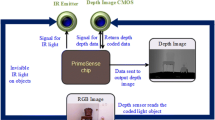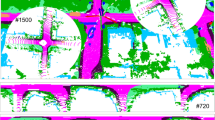Abstract
To navigate in an unknown environment, a robot should build a model for the environment. For outdoor environments, a three-dimensional (3-D) map is usually used as a main model. This study considers outdoor simultaneous localization and mapping (SLAM) to build a global 3-D map by matching local 3-D maps. An iterative closest point (ICP) algorithm is used to match local 3-D maps and estimate a robot pose, but an alignment error is generated by the ICP algorithm due to the false selection of corresponding points. We propose a new method to extract 3-D points that are valid for ICP matching. Rotation-invariant descriptors are introduced for robust correspondence. 3-D environmental data acquired by tilting a 2-D laser scanner are used to build local 3-D maps. Experimental results in real environments show the increased accuracy of the ICP-based matching and a reduction in matching time.
Similar content being viewed by others
References
Lee, Y.J., Yim, B.D., Song, J.B.: Mobile robot localization based on effective combination of vision and range sensors. Int. J. Control Autom. Syst. 7(1), 97–104 (2009)
Dellaert, F., Fox, D., Burgard, W., Thrun, S.: Monte Carlo localization for mobile robots. In: Proc. IEEE Int. Conf. Robotics and Automation, pp. 1322–1328 (1999)
Lee, Y.J., Song, J.B.: Three-dimensional iterative closest point-based outdoor SLAM using terrain classification. Intel. Serv. Robotics 4(2), 147–158 (2011)
Parra, C., Murrieta, R., Devy, D., Briot, M.: 3-D Modeling and robot localization from visual and range data in natural scenes. Conf. Vis. Syst. LNCS. 1542, 450–468 (1999)
Pfaff, P., Triebel, R., Burgard, W.: An efficient extension to elevation maps for outdoor terrain mapping and loop closing. Int. J. Rob. Res. 26(2), 217–230 (2007)
Hebert, M.: Active and passive range sensing for robotics. In: Proc. IEEE Int. Conf. Robotics and Automation, pp. 102–110 (2000)
Huber, D., Carmichael, O., Hebert, M.: 3D map reconstruction from range data. In: Proc. IEEE Int. Conf. Robotics and Automation, pp. 891–897 (2000)
Choi, J.H., Park, Y.W., Song, J.B., Kweon, I.S.: Localization using GPS and vision-aided INS with image database and a network of ground-based reference station in outdoor environments. Int. J. Control. Autom. Syst. 9(4), 716–725 (2011)
Lu, F., Milios, E.: Robot pose estimation in unknown environments by matching 2D range scans. J. Intell. Robot. Syst. 18(3), 249–275 (1997)
Nuchter, A., Lingemann, K., Hertzberg, J., Surmann, H.: 6D SLAM-3D mapping outdoor environments. J. Field Robot. 24(8–9), 699–722 (2007)
Frueh, C., Zakhor, A.: An automated method for large-scale ground-based city model acquisition. Int. J. Comput. Vis. 60(1), 5–24 (2004)
Triebel, R., Burgard, W.: Improving simultaneous mapping and localization in 3-D using global constraints. In: Proc. of the National Conf. on Artificial Intelligence, pp. 1330–1335 (2005)
Triebel, R., Pfaff, P., Burgard, W.: Multi-level surface maps for outdoor terrain mapping and loop closing. In: Proc. of IEEE/RSJ Int. Conf. of Robotics and Systems, pp. 2276–2282 (2006)
Besl, P.J., McKay, N.D.: A method for registration of 3-D shapes. IEEE Trans. Pattern Anal. Mach. Intell. 14(2), 239–256 (1992)
Rusinkiewicz, S., Levoy, M.: Efficient variants of the ICP algorithm. In: Proc. of Conf. on 3D Digital Imaging and Modeling (2001)
Nuchter, A., Lingemann, K., Hertzberg, J.: Cached k-d tree search for ICP algorithms. In: Proc. of Int. Conf. on 3-D Digital Imaging and Modeling, pp. 419–426 (2007)
Chen, Y., Medioni, C.: Object modeling by registration of multiple range images. In: Proc. of IEEE Int. Conf. on Robotics and Automation, pp. 2724–2729 (1992)
Park, S.Y., Subbarao, M.: An accurate and fast point-to-plane registration technique. Pattern Recogn. Letts. 24(16), 2967–2976 (2003)
Gelfend, N., Ikemoto, L., Rusinkiewicz, S., Levoy, M.: Geometrically stable sampling for the ICP algorithm. In: Proc. of 3-D Digital Imaging and Modeling, pp. 260–267 (2003)
Lacrois, S., Mallet, A., Bonnafous, D., Bauzil, G., Fleury, S., Herrb, M.: Autonomous rover navigation on unknown terrains: functions and integration. Int. J. Rob. Res. 21(10–11), 917–942 (2002)
Weingarten, J.W., Gruener, G., Siegwart, R.: Probabilistic plane fitting in 3D and an application to robotic mapping. In: Proc. of the IEEE Conference on Robotics and Automation, pp. 927–932 (2004)
Author information
Authors and Affiliations
Corresponding author
Rights and permissions
About this article
Cite this article
Lee, YJ., Song, JB. & Choi, JH. Performance Improvement of Iterative Closest Point-Based Outdoor SLAM by Rotation Invariant Descriptors of Salient Regions. J Intell Robot Syst 71, 349–360 (2013). https://doi.org/10.1007/s10846-012-9786-2
Received:
Accepted:
Published:
Issue Date:
DOI: https://doi.org/10.1007/s10846-012-9786-2




